|
Related FAQs: Sponges, Sponges
2, Sponges 3,
Sponges 4, Sponge Identification, Sponge ID 2, Sponge ID 3, S Sponge ID
4, Sponge ID
5, Sponge ID 6, Sponge ID 7, Sponge ID
8, Sponge ID 9, Sponge ID 10, Sponge ID 11, Sponge ID 12, Sponge ID 13, Sponge ID 14, Sponge ID 15, Sponge ID 16, Sponge ID 17, Sponge ID
18, Sponge ID 19,
Sponge ID 20, Sponge ID 21,
& Sponge Selection, Sponge Compatibility, Sponge Systems, Sponge Feeding, Sponge Disease, Sponge
Reproduction,
Related Articles: Invertebrates, Live
Rock, Ascidians/Sea Squirts,
Review of
Tyree's "Cryptic Filtration" Book
/The Best Livestock For Your Reef Aquarium:
Sponges, Phylum Porifera, Part 9
To: Sponges
Part 1, Part
2, Part 3, Part 4,
Part 5, Part 6,
Part 7, Part 8,
Part 10,
|
|
|
By Bob Fenner
|
|
Family Spirastrellidae: Characterized as most Poriferans by
minute structural details. Contain peculiar spicules (spinispirae).
Megascleres are tylostyles, generally radially arranged. Some species
bore into rock, corals, leading to their disintegration.
| Spirastrella coccinea, a relatively common
encrusting sponge, here in Cozumel, a close-up by Diana.F. |
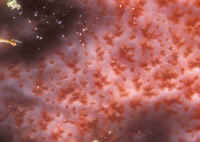
|
Bigger PIX:
The images in this table are
linked to large (desktop size) copies. Click on "framed"
images to go to the larger size. |
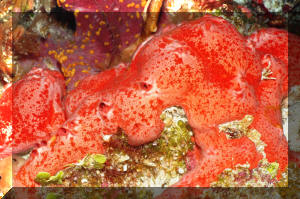
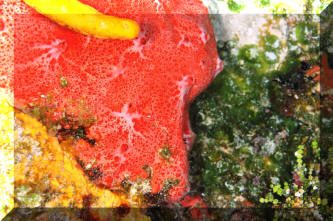
 |
| Spirastrella hartmani, High-Veined Encrusting Sponge.
Salmon to light orange in color. Distinctive raised elements with ribs and
big osculae. Roatan 2019. |
%20MD.JPG)
|
| Spirastrella (Sphenciospongia)
vagabunda Ridley 1884, the Vagabond Boring Sponge. Bores its
way into carbonate places (rock, corals...) by acidic secretion. An
important group of organisms for "recycling" limestone.
Hawai'i photos. |
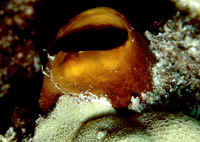 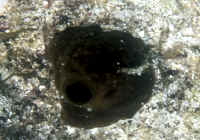
|
Bigger PIX:
The images in this table are linked
to large (desktop size) copies. Click on "framed" images
to go to the larger size. |
|
%20MD.JPG)
|
Genus Strongylophora:
| Strongylophora sp., Amorphous Cave Sponge.
Creamy though hard to the touch, fuzzy finger-like appearance.
Found deep in caves and lava tubes (Pukas), covering walls at
times. Kona pix. |
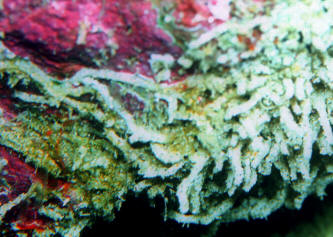
|
Genus Stylinos:
| Stylinos sp., Orange Stylinos Sponge. Rough
cellulose appearance. Soft material that is easily torn, but
don't touch. This sponge will stain and irritate skin. Only a
few inches across. Kona pix. |
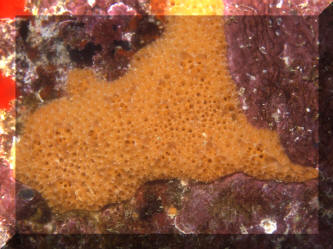
|
Genus Stylotella:
| Stylotella aurantium (Halicohondrida,
Halichondriidae), Fiji and the P.I. |
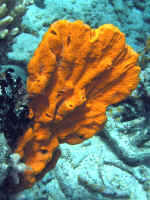 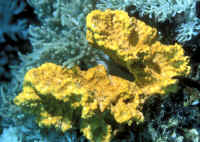
|
Genus Suberites:
| Suberites sp., Blue Suberites Sponge.
Intensely blue, as thin sheets. Occurs in high surge areas.
Colonies in crevices are a few inches across. Kona pix. |
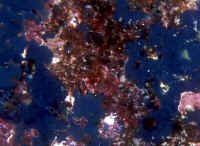
|
Bigger PIX:
The images in this table are linked
to large (desktop size) copies. Click on "framed" images
to go to the larger size. |
|
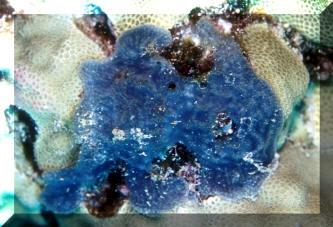
|
Genus Tedania:
| Tedania ignis, Fire Sponge. Tropical West
Atlantic down to 35 ft. 4-12 inches overall. Distinctive
volcano-like excurrent openings. Orange to bright red in color
overall. Irritating to the touch. Bahamas and Bonaire
pix. |
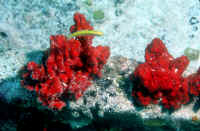 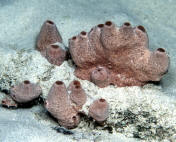
|
Bigger PIX:
The images in this table are linked
to large (desktop size) copies. Click on "framed" images
to go to the larger size. |
|
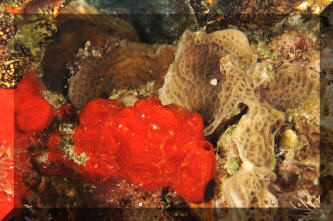
|
Genus Theonella:
| Theonella swinhoei Red Sea image. |
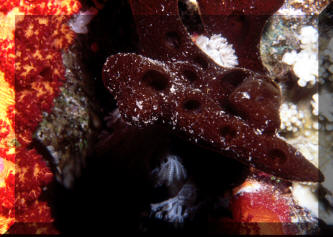
|
Genus Ulosa:
| Ulosa ruetzleri, the Orange Lumpy Encrusting Sponge. Up
to a foot across. Found mostly about dead corals and Mangrove
roots. TiffB pic in Curacao. |
%20MD.JPG)
|
Genus Xestospongia:
| Xestospongia muta, the Giant Barrel Sponge.
To six feet in height. Rough, jagged, very hard exterior. Bahamas pic. |
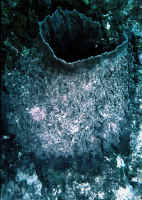
|
To: Sponges
Part 1, Part
2, Part 3, Part 4,
Part 5, Part 6,
Part 7, Part 8,
Part 10,
|
|

